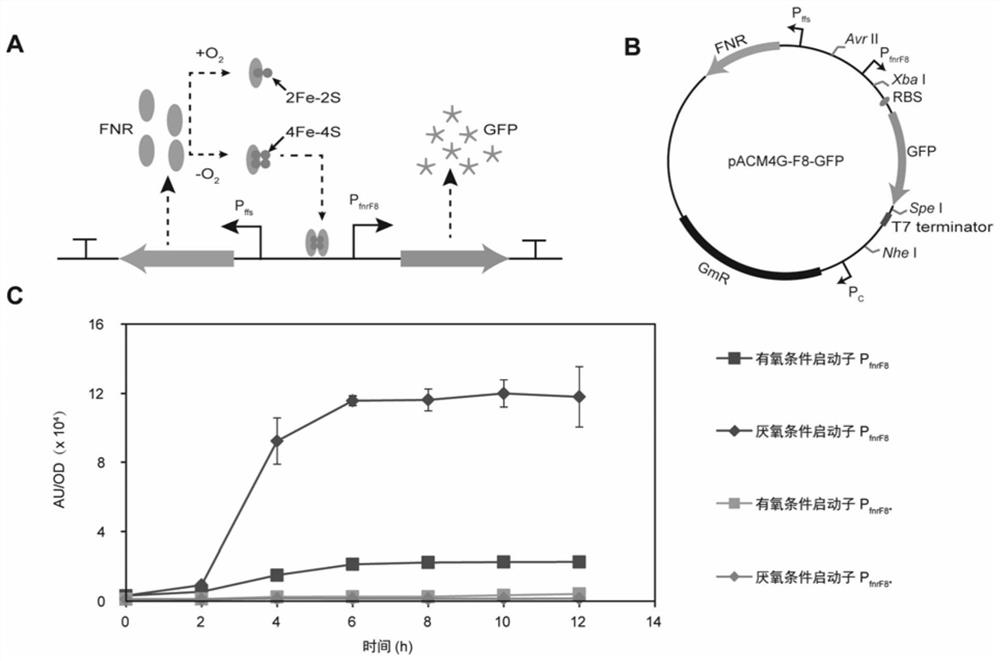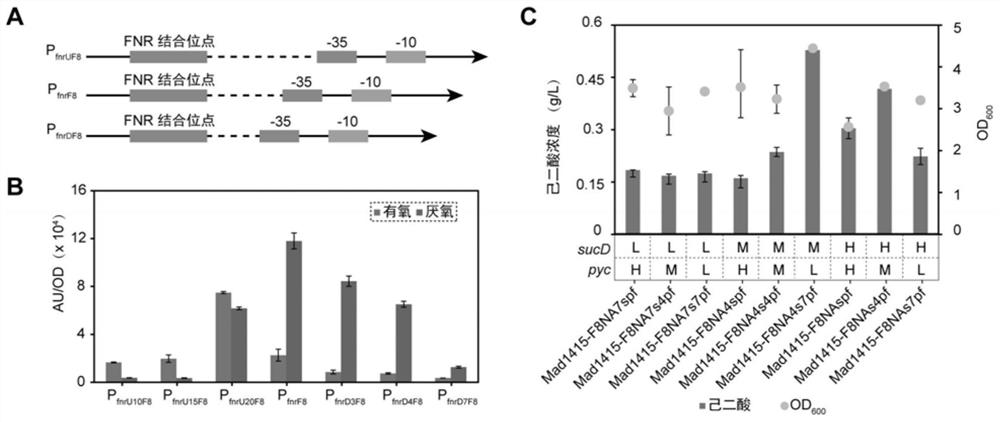Construction method and application of oxygen response type biosensor
A biosensor and promoter technology, applied in the field of synthetic biology, can solve the problems of not being well adapted to the distribution between the growth and production of metabolic flow, affecting the growth of cells or the production of target compounds, etc.
- Summary
- Abstract
- Description
- Claims
- Application Information
AI Technical Summary
Problems solved by technology
Method used
Image
Examples
Embodiment 1
[0048] Example 1 Construction of an oxygen-responsive biosensor
[0049] Such as figure 1 As shown in B, the sensor plasmid is mainly composed of 3 parts: 1) FNR gene and its upstream promoter P ffs ; 2) anaerobic-inducible promoter P containing FNR transcriptional activator targeting binding site fnrF8 3) GmR resistance gene and its upstream promoter P c .
[0050] Anaerobic inducible promoter P fnrF8 Located between the restriction site Avr II and Xba I of the plasmid pACM4G, and integrated with the FNR transcriptional activator targeting binding site; the promoter P fnrF8 Induces the expression of the target gene; promoter P ffs Located upstream of the restriction site Avr II of the plasmid pACM4G, it induces the expression of the downstream FNR gene; the GmR resistance gene is located downstream of the FNR gene, and is controlled by the upstream P c Promoter induces expression.
[0051] Using the Escherichia coli K12 MG1655 genome as a template, the FNR fragment was...
Embodiment 2
[0056] Example 2 Response Performance Evaluation of Oxygen Responsive Biosensor
[0057] Fumarate and nitrate reductase (FNR) transcriptional activator-dependent biosensors are currently the most studied oxygen-responsive biosensors. As a transcriptional activator, FNR mediates the transition from aerobic to anaerobic metabolism by regulating gene transcription. , whose activity switches between 4Fe-4S and 2Fe-2S clusters with oxygen content ( figure 1 A), under anaerobic conditions, FNR binds to 4Fe-4S clusters to change the conformation of the protein, then dimerizes and binds to specific sites in the promoter region, and finally activates the protein to activate related anaerobic metabolism In the expression of related genes in the pathway, in the presence of oxygen, 4Fe-4S clusters are oxidized to 2Fe-2S clusters, while the dimers decompose and the FNR protein loses its activity.
[0058] The response performance of the biosensor under aerobic and anaerobic conditions was...
Embodiment 3
[0059] Example 3 Screening of different strength anaerobic inducible promoters
[0060] FNR transcriptional activators are known to achieve normal transcription of downstream genes by targeting specific domains of promoters. fnrF8 In , the FNR targeting binding site is located upstream of the promoter-35 region ( figure 2 A), changing the distance between the two may affect the response performance of the biosensor, resulting in differences in the expression levels of genes downstream of the promoter.
[0061] Performance testing was carried out under aerobic and anaerobic conditions respectively, and the blank plasmid pACM4G-F8*-GFP without the FNR targeting binding site was used as a control, and the sensor plasmids pACM4G-F8-GFP, pACM4G- U10F8-GFP, pACM4G-U15F8-GFP, pACM4G-U20F8-GFP, pACM4G-D3F8-GFP, pACM4G-D4F8-GFP and pACM4G-D7F8-GFP were introduced into Escherichia coli JM109 for biosensor performance evaluation.
[0062] The result is as figure 2 As shown in B, inc...
PUM
 Login to View More
Login to View More Abstract
Description
Claims
Application Information
 Login to View More
Login to View More - R&D
- Intellectual Property
- Life Sciences
- Materials
- Tech Scout
- Unparalleled Data Quality
- Higher Quality Content
- 60% Fewer Hallucinations
Browse by: Latest US Patents, China's latest patents, Technical Efficacy Thesaurus, Application Domain, Technology Topic, Popular Technical Reports.
© 2025 PatSnap. All rights reserved.Legal|Privacy policy|Modern Slavery Act Transparency Statement|Sitemap|About US| Contact US: help@patsnap.com



